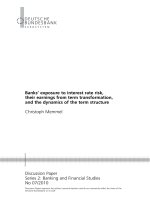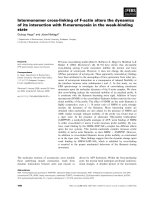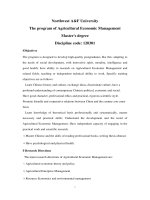the mit press adaptive governance the dynamics of atlantic fisheries management nov 2008
Bạn đang xem bản rút gọn của tài liệu. Xem và tải ngay bản đầy đủ của tài liệu tại đây (3.06 MB, 415 trang )
D. G. Webster
foreword by Oran R. Young
The Dynamics of Atlantic
Fisheries Management
Adaptive Governance
Adaptive Governance
Global Environmental Accord: Strategies for Sustainability and
Institutional Innovation
Nazli Choucri, series editor
A complete list of books published in the Global Environmental Accord series
appears at the back of this book.
Adaptive Governance
The Dynamics of Atlantic Fisheries Management
D. G. Webster
The MIT Press
Cambridge, Massachusetts
London, England
( 2009 Massachusetts Institute of Technology
All rights reserved. No part of this book may be reproduced in any form by any
electronic or mechanical means (including photocopying, recording, or informa
tion storage and retrieval) without permission in writing from the publisher.
For information about special quantity discounts, please email special sales@
mitpress.mit.edu
This book was set in Sabon on 3B2 by Asco Typesetters, Hong Kong.
Printed on recycled paper and bound in the United States of America.
Library of Congress Cataloging in Publication Data
Webster, D. G., 1975
Adaptive governance : the dynamics of Atlantic fisheries management / D. G.
Webster.
p. cm. (Global environmental accord)
Includes bibliographical references.
ISBN 978 0 262 23270 8 (hardcover : alk. paper) ISBN 978 0 262 73192 8
(pbk. : alk. paper) 1. Fishery management. 2. Fishery policy.
3. Intergovernmental cooperation. I. Title.
SH328.W43 2008
338.3
0
727 dc22 2008017103
10987654321
In memory of Bob Friedheim, who introduced me to the study of global
environmental issues, and Hayward Alker, who told me that I had to
write this book.
Contents
Series Foreword ix
Foreword xi
Preface xv
Acknowledgments xvii
1 Adaptive Governance 1
2 The Vulnerability Response Framework 17
I Tropical Tunas 47
3 Bigeye Tuna 51
4 Yellowfin Tuna 71
5 Skipjack Tuna 85
II Billfishes 107
6 Northern Swordfish 113
7 Southern Swordfish 133
8 Blue Marlin and White Marlin 151
III Bluefin Tuna 169
9 Western Bluefin Tuna 173
10 Eastern Bluefin Tuna 195
11 Conclusion 227
Appendix A Group of 18 255
Appendix B Comprehensive Vulnerability Classifications 257
Appendix C Summary of Evidence from the Cases 275
Appendix D Proxy Indicators for Competitiveness 291
Appendix E Proxy Indicators for Flexibility 297
Appendix F Delineating High-Flex and Low-Flex Phases for Gradually
Vulnerable Countries 343
Notes 349
References 373
Index 381
viii Contents
Series Foreword
A new recognition of profound interconnections between social and nat-
ural systems is challenging conventional constructs and the policy pre-
dispositions informed by them. Our current intellectual challenge is to
develop the analytical and theoretical underpinnings of an understand-
ing of the relationship between the social and the natural systems. Our
policy challenge is to identify and implement effective decision-making
approaches to managing the global environment.
The series Global Environmental Accord: Strategies for Sustainability
and Institutional Innovation adopts an integrated perspective on na-
tional, international, cross-border, and cross-jurisdictional problems, pri-
orities, and purposes. It examines the sources and the consequences of
social transactions as these relate to environmental conditions and con-
cerns. Our goal is to make a contribution to both intellectual and policy
endeavors.
Nazli Choucri
Foreword
Adaptive Governance: The Dynamics of Atlantic Fisheries Management
sheds light on an important aspect of international environmental gover-
nance that has largely escaped the attention of analysts bent on under-
standing the roles that environmental and resource regime s play both in
causing problems and in addressing issues that arise in a variety of set-
tings. In the early years, students of environmental governance focused
on processes of regime formation, seeking to explain why regimes form
to address some problems but not others. Subsequent analyses have dealt
with the effectiveness of regimes in altering behavior or solving prob-
lems. Now attention is shifting to a search for understanding the ways
in which regimes change over time. Largely overlooked in research deal-
ing with these issues are a series of questions regarding the ongoing man-
agement activities that consume the lion’s share of the time and energy
of those involved with individual regimes as they go about the business
of applying the provisions of these institutional arrangements to day-to-
day concerns. How well do decision-making procedures work in ad-
dressing routine matters? Are there identifiable patterns in the results
that flow from the use of these procedures on an ongoing basis? Can
decisions about routine matters trigger processes that lead to major insti-
tutional changes? Can we identify the factors that account for variance
in these terms?
Analysts have addressed questions of this sort in other issue areas.
There are, for example, a number of studies that delve into such matters
with regard to the operation of the World Trade Organization. How-
ever, sustained empirical studies of the day-to-day operation of environ-
mental and resource regimes are few and scattered. Now, D. G. Webster
has taken direct aim at this topic in the realm of international environ-
mental governance. Grounding her work in an in-depth assessment of
the operation of the International Convention for the Conservation of
Atlantic Tunas (ICCAT), she explores the selection of management mea-
sures pertaining to a number of highly migratory species—mainly tunas,
swordfish, and marlins—that fall under the jurisdiction of this conven-
tion. A close examination reveals that there is considerable variance in
the management measures that ICCAT has adopted both in dealing
with different species and in dealing with the same species over time.
What accounts for this variance across a universe of cases involving the
management of highly migratory species that seem quite similar? This is
the sort of challenge that warms the heart of researchers in the social
sciences who are on the lookout for opportunities to conduct natural
experiments. There is significant variance in the dependent variable. Yet
many aspects of the relevant setting remain constant by virtue of the fact
that they pertain to a single management regime that has not experienced
any dramatic or watershed changes in its constitutive provisions since its
formation in 1966.
Confronted with this puzzle, Webster goes to work to develop an ex-
planatory framework capable of accounting for the observed variance in
the selection of management measures across species and time. Because
the voting members of this regime are states, she focuses on the behavior
of states, treating them for the most part as unitary actors that have rel-
atively well-defined interests regarding the management of highly migra-
tory species. And because the regime focuses on the pursuit of maximum
sustainable yields from harvested species, she concentrates on decisions
pertaining to the setting of allowable harvest levels and related matters
on a species-by-species basis. Those interested in the rise of ecosystem-
based management as an alternative to maximum sustainable yield in
framing issues of governance and intrigued by the growing role of vari-
ous nonstate actors in environmental governance may be impatient with
this concentrated effort to explain the behavior of the regime created
under the terms of ICCAT. Nevertheless, this regime is representative of a
sizable number of environmental governance systems now in operation.
Whatever our preferences and hopes for the future, it is surely important
to enhance our ability to explain outcomes unde r the conditions prevail-
ing today.
To explain variance in the choice of management measures affect-
ing highly migratory species, Webster develops what she calls a ‘‘vul-
nerability response framework.’’ This framework seeks to classify states
interested in the harvest of specific species into categories (e.g., highly
xii Foreword
vulnerable, gradually vulnerable, and so forth) based largely on consider-
ations of economic flexibility and competitiveness. The resultant vulner-
ability matrix for each species provides a method for assessing the
bargaining strength of the key players and a line of reasoning in which
movements toward or away from strong management measures are
expected to reflect the preferences of the player(s) with the greatest bar-
gaining strength in the relevant arena. A series of chapters apply this
framework to the selection of management measures for individual
species under ICCAT’s jurisdiction with results that accord well with
observed outcomes.
As Webster he rself makes clear, this line of analysis has significant lim-
itations. The engine that drives the model is in some ways underspecified.
The categories differentiating among levels of vulnerability are hard to
operationalize with regard to specific species. The number of cases is
too small to support claims of a statistical nature. And since the manage-
ment measures selected with regard to individual species are known at
the outset, there is a danger that interpretations developed for specific
cases will be adjusted—if only unintentionally—to generate the ‘‘right’’
answers. Still, Webster has taken a significant step forward in generating
expectations about the selection of management measures, and she offers
a number of helpful suggestions to those who may be inter ested in devel-
oping this mode of analysis further. As a point of departure for addi-
tional work in this field, this book has much to offer.
It is important to be clear about several larger limitations of this study
as well. It is tempting to see links between the selection of management
measures and the condition of various stocks of highly migratory species,
and such links may well occur in individual cases. An analysis that fo-
cuses on variance in the selection of management measures can detect
pressures for signi ficant changes in the status quo. However, it cannot
provide unambiguous evidence regardi ng the role of a regime in main-
taining species or stocks of individual sp ecies in a healthy condition.
The range of biophysical and socioeconomic drivers operating simultane-
ously and likely to have some impact on the condition of a species is too
great to allow us to identify precise links of this sort. Beyond this lies the
question of generalizability. Webster’s account of the vulnerability re-
sponse framework and its capacity to explain variance in the selection
of management measures rests on a close encounter with a single regime.
This is not a defect in the argument that she presents in this book. Still, it
is pertinent to ask whether the analysis is capable of explaining variance
Foreword xiii
in the selection of management measures in other fisheries management
regimes and ultimately in a broader range of environmental and resource
regimes operating at the international or transnational level today. This
will be a challenge for those who find the vulnerability response frame-
work attractive a nd wish to explore the extent to which it can be trans-
ported to other settings.
These observations about the limits of Webster’s argument are impor-
tant, but they must not be allowed to obscure or diminish the signifi-
cance of her achievements. Although the effort to explain variance in
the day-to-day operations of environmental governance systems is clearly
important, mainstream work in this field has largely ignored this matter.
Webster rightly calls our attention to this fact and proceeds to develop
an analytic tool capable of explaining this variance. Whatever its fate in
the long run, her work constitutes a prominent contribution to our un-
derstanding of this impor tant phenomenon. Analysts interested in this
topic in the future will have to reckon with Webster’s contribution,
whether they conclude that some alternative is needed or simply seek to
flesh out the vulnerability response framework and to sharpen it for ap-
plication to a range of specific cases. In either case, her work will have
played a significant role in the ongoing effort to improve our understand-
ing of environmen tal governance.
Oran R. Young
Santa Barbara, California
December 2007
xiv Foreword
Preface
This book is the culmination of many years of work on the problem of
global environmental governance generally and the process of interna-
tional fisheries management specifically. Even so, it is a beginning rather
than an ending. While the ideas underlying the framework of vulnera-
bility response have an intuitive appeal in many arenas, they are opera-
tionalized here only in the realm of international fisheries management.
Furthermore, the cases themselves are drawn from a single regime, the
International Commission for the Conservation of Atlantic Tunas
(ICCAT). While comparison among multiple regimes would certainly be
useful, the path of my research led to a choice between expansion to
other management institutions or the inclusion of the last two cases,
which cover Atlantic bluefin tuna. Because this species is so important
economically and biologically, and in the development of tuna manage-
ment world-wide, I chose the latter option. Plans for additional cases
from other fisheries regimes and the development of more formal compu-
tational techniques are already under way, and it is my great hope that
the ideas presented here will lead to much more expansive research into
other forms of human response to environmental change and resultant
patterns of adaptive governance.
Readers who would like to explore the data used in this analysis can
find it at governance.
Acknowledgments
This book would not have been possible without the advice and assis-
tance of many people. First my thanks go to the Offield Family Founda-
tion, Paxson Offield, and the University of Southern California’s Wrigley
Institute for Environme ntal Studies for their consistent support of my re-
search. The Alice C. Tyler Charitable Trust and John C. Tyler Trust, the
Haynes Foundation, the Rose Hills Foundation, and the Florence and A.
Leroy Webster Trust also provided much-appreciated funding.
On the academic side, I am grateful to John Elliot, Anthony F.
Michaels, Robert Friedheim, and Linwood Pendleton for starting my re-
search off in the right direction and to Timur Kuran and Hayward Alker
for seeing it through to the end. These mentors challenged me to go be-
yond conventional perspectives in economics and international relations
and helped me to bridge many of the gaps between the two. I am also
indebted to Oran Young and two anonymous reviewers for their excel-
lent insights on my initial manuscript. Their comments helped me to
streamline my writing and the overall organization of this book.
When I first started this project, I had no idea how deeply I would be
drawn into the world of international fisheries management. It is a com-
plicated busines s, but I had exceptional guidance from scientists like
John Graves, Gary Sakagawa, Michael Hinton, Victor R. Restrepo, Peter
Miyake, and John Mark Dean, as well as decision makers such as Robin
Allen, Davi d Ardill, David Balton, Raleigh Schmitten, Masanori Miya-
hara, Peter S. C. Ho, John Spencer, Kim Blankenbecker, Alan Gray, and
Xavier Vant. Many representatives of interest group also took the time
to explain their positions to me. These include David Wilmont, who—
along with John Graves—got me into my first ICCAT meeting, Ellen
Peel, Helen Bours, Nelson Beideman, Richard Ruis, Robert Hayes,
and Susan Singh-Renton. Special appreciation goes to Russell Dunn and
David Kerstetter for helping me through that first meeting, along with
many others, and Philomena Seidita for her assistance with the labyrinth
of ICCAT documents.
On a more personal note, I’d like to thank Julie Brown, Farideh Mota-
medi, and Cindy Locken for their technological and moral support, and
my parents, Ronald and Sandra K. Webster, for their unwavering faith
in my abilities.
xviii Acknowledgments
Adaptive Governance
1
Adaptive Governance
Progress is an ambiguous phenomenon. It has driven humanity’s pros-
perity, yet it also comes with unintended effects, such as resource de-
pletion, ecosystem disruptions, and climate change. Coping with these
problems is a struggle in itself, one that depends on the coordinated
actions of many individuals. Furthermore, while there are those who vol-
untarily eschew the comforts of consumerism, there are considerable
numbers of people who are vested in the current economic system. For
these individuals—whether they are producers, consumers, and/or deci-
sion makers—dealing with the side effects of progress is costly. Because
so few are willing to sacrifice their way of life, early warnings of poten-
tially catastrophic events can go unhe eded for decades as ‘‘progress’’
rolls on (Rosenau 1993, 258).
For instance, in fisheries, progress has meant bigger, faster boats, more
efficient capture techniques, and a wider availability of fish for human
consumption—as well as profits, jobs, and other economic benefits. At
the same time, the rapid expansion of fishing effort in the past century
has caused major concern regarding the long-term viability of living ma-
rine resources, whether or not they are commercially valuable. To their
detriment, fishers and governments alike have been unable to curtail ex-
cess fishing effort in many areas in spite of strong scientific and economic
evidence of overexploitation. Recent collapses of important fisheries like
Pacific anchoveta and the North Atlantic groundfishes, which include
cod, haddock, plaice, and halibut, have shown how acute such failures
can be. On the other hand, as Hilborn, Orensanz, and Parma (2005)
point out, some other important fisheries, like north Pacific halibut,
have been well managed.
What is even more interesting is that almost every documented exam-
ple of sustainable fisheries management has occurred, not by design
alone, but through an adaptive process. That is, the most effective mea-
sures are not born whole in the heads of managers, but are usually the
result of trial and error. Certainly, design is involved, as the huge body
of literature on fisheries management shows. However, observation sug-
gests that fishers and managers learn by first trying and failing with mea-
sures that are less costly but also less effective before they become willing
to accept the sacrifices required for successful regulation. The same can
be said of the international institutions that govern shared and high-seas
fisheries. The rules and norms of decision making may seem frustratingly
static for long periods, but change does occur as fishing countries are
forced to cope with the troubles that arise under open access.
Figure 1.1 shows how the ideal-type or pure form of adaptive fisheries
governance might work in the international arena. On the left-hand side
of the figure, the usual downward spiral associated with open access has
been expanded to include political responses to the costs of resource de-
pletion. This is the preliminary metastable state. Management is ineffec-
tive, but—at least at the international level—the syste m seems static.
However, underneath this element, pressure is building from the ‘‘bot-
tom up.’’ As the resource gets smaller and smaller, fishers face growing
competition, and policy makers are more and more dissatisfied with the
status quo. If periodic release of this pressure occurs through partial
management interventions, then the system might persist for a long
time. It might even shift gradually into the effective management cycle
pictured on the right-hand side of the figure. However, rapid change is
Figure 1.1
Pivotal cycle in common pool resource management.
2 Chapter 1
also possible, including the sudden collapse of the regime or the stock(s)
in its jurisdiction.
In fact, the simplicity of figure 1.1 is quite deceptive. There are many
different microlevel interactions and context-specific elements that con-
trol the strength and flow of this macrolevel system (Schelling 1978; Put-
nam 1988). Actors may be affected or respond at different rates, creating
different levels of aggregate concern. Options often depend on available
technologies and instituti onal precedents, so the potential for change is
limited at any given point in time. Complex dynamics and stochastic ele-
ments can also distort the causal links that are depicted so clearly in the
figure, creating a pattern of ‘‘one step forward, two steps back, then
maybe a couple of steps sideways.’’ In fact, the only certainty is that
the system will always be in flux, and that for every action there will be
a reaction—sometimes equal, sometimes amplified by feedb acks, and
sometimes nullified by exogenous forces.
All of this makes it quite difficult to understand adaptive governance.
The vulnerability response framework developed in this book is a meso-
level perspective that falls between the thin approach es of economic and
game theory-based work and a thick approach, which relies heavily on
detailed case descriptions (Young 2002). It will guide the development
of predictions regarding the evolution of countries’ policy positions that
can then be tested using cases from the International Commission for
the Conservation of Atlantic Tunas (ICCAT, pronounced ı-kat), which
manages highly migratory fish species in the Atlantic. This analysis is an
important first step toward understanding adaptive governance in inter-
national fisheries. Collective decisions on management are not predicted,
but are reported in the cases so that emergent patterns of collective out-
comes can be identified in the final chapter.
After a brief background on the politics and econ omics of highly mi-
gratory species (HMS) in section 1.1, the rest of this chapter outlines
some important innovations in the international management of these
valuable and beleaguered fish. As described in sections 1.2 and 1.3, the
most important of these innovations was developed by ICCAT . Several
of the stocks that are managed by the Commission have been severely
depleted, but ICCAT has also developed new management tools that
include specific allocation of access rights and international monitoring
and enforcement mechanisms. Furthermore, there has been some intri-
guing variation in the application of these measures that needs to be
explained. Finally, section 1.4 elaborates on the need for a combined
Adaptive Governance 3
perspective in order to explore both the static and dynamic aspects of
adaptive management in the HMS context.
1.1 The HMS Context
Highly migratory species are some of the Earth’s most important renew-
able resources and present some of the most complicated practical issues
for sustainable use. As top end predators, they play a key role in the ma-
rine ecosystem, ensuring that populations of smaller fish do not exceed
the carrying capacity of the oceans (Berkes et al. 2006). In addition, the
commercial value of these species is quite large and is distributed across
many fleets. More than 150 countries and ‘‘fishing entities’’ harbor fleets
targeting HMS stocks, supplying the world with almost half a million
tons of fish per year (FAO 2007b).
1
Furthermore, half of all HMS har-
vests are traded internationally at an export value of over US $5 billion,
surpassed among fish products only by shrimp and groundfish (FAO
2006).
These aggregate statistics conceal some variations among the species.
Adult tunas, especially bluefin and bigeye, are prized by sushi and sa-
shimi connoisseurs and can bring very high prices for quality fish. Ju-
venile and small tunas are packaged and sold in large quantities at low
prices. Swordfish, which is also commercially targeted, is consumed
mainly in high-end restaurants in the United States and Europe. There
are some less prolific highly migratory species that command low prices,
including several stocks of billfish. Some, like white marlin, are only
caught incidentally; these stocks are by-catch, rather than targeted spe-
cies, in commercial fishing operations (Majkowski 2005; FAO 2007c).
As might be expected, growing demand for highly migratory species
has precipitated considerable expansion of the fishing industry targeting
these stocks. This in turn has resulted in the depletion of many of these
fisheries. Of the twenty-four major market tunas, thirteen are estimated
to be overexploited, six are fully exploited, and only four are moderately
exploited (De Leiva Moreno and Majkowski 2005). Of the six stocks of
swordfish in the major oceans, at least two are thought to be moderately
overexploited and the rest are at full exploitation. Several by-catch
stocks, including white marlin and Atlantic blue marlin, are also heavily
depleted (IATTC 2006; ICCAT 2007a; IOTC 2005).
It is generally believed that the overexploitation of targeted stocks is
due to the common pool nature of high seas fishing, which is open to
4 Chapter 1









